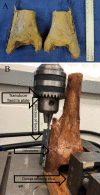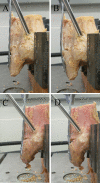Mini-Blade Plate to Obtain Length Across Lateral Malleolus Fractures: Surgical Technique and Biomechanical Evaluation
- PMID: 35342527
- PMCID: PMC8921462
- DOI: 10.1007/s43465-021-00562-8
Mini-Blade Plate to Obtain Length Across Lateral Malleolus Fractures: Surgical Technique and Biomechanical Evaluation
Abstract
Background: Restoration of fibular length is the main determinant in preventing mal-union and early ankle arthritis in lateral malleolus fractures. A 1/3 tubular plate fashioned into a mini-blade plate can be used to distract the distal fragment and achieve length in a controlled fashion over time. The purpose of this study was to describe the surgical technique and perform a biomechanical comparison of the blade plate to a locking plate.
Methods: A 1/3 tubular plate is fashioned into a 135° blade plate. Blades are seated into the lateral malleolus and a distally directed force is applied on the plate to obtain length.A lateral malleolus fracture was created in 20 cadaveric ankles. The distal fragment was fixed with either a blade plate (BP, n = 10) or a locking plate (LP, n = 10). A distally directed force was applied by an Instron machine and fracture distraction, maximal load and construct stiffness were measured and compared.
Results: The average maximal load was 262.06 N compared to 255.52 N for the BP and LP groups, respectively. The maximal distraction was 3.57 mm compared to 4.57 mm for the BP and LP groups, respectively. The loading pattern of the blade plate over time differed from that of a locking plate as the blades seat into bone.
Conclusion: A 1/3 tubular mini-blade plate demonstrates biomechanical similarities in terms of load and distraction to the more expensive locking plate. We recommend using this technique for fractures with late presentation or with significant shortening.
Level of evidence: Level V-Mechanism-based reasoning.
Keywords: Biomechanical; Blade plate; Lateral malleolus; Locking plate; Push–pull.
© Indian Orthopaedics Association 2021.
Conflict of interest statement
Conflict of interestAll authors of this article have no financial or other conflicts of interest to declare.
Figures





References
-
- Davidovitch R, Egol K. Ankle fractures. In: Bucholz RW, Court-Brown CM, Heckman JD, Tornetta P III, editors. Rockwood and Green’s fractures in adults. 7. Philadelphia: Lippincott Williams & Wilkins; 2010. pp. 1974–2021.
Grants and funding
LinkOut - more resources
Full Text Sources
Research Materials
